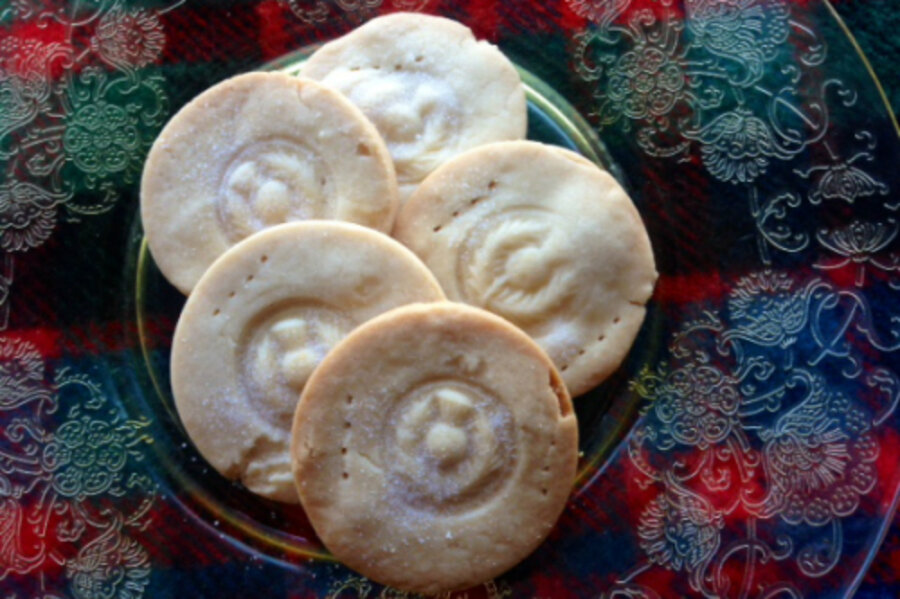Scottish independence: A thistle on every shortbread cookie
Loading...
Scotland’s polls have opened to the referendum vote that will decide if Scotland will be a nation independent of Great Britain. Some analysts say its too close to know what the result will be once the 4.2 million voters have cast their ballot. The world is watching, not just for its economic ramifications, but because Scottish culture is well-loved – tartan plaid, bagpipes, the Loch Ness Monster, Robert Burns, and Scottish shortbread – are just a a few of the ways the Scots have fed imaginations worldwide for centuries.
As the Queen said recently, I hope the Scots "think very carefully about the future," as they head to the polls.
I've got an eye on the past, too. Growing up with a Scottish grandmother (my mom’s stepmother) I have always had a wee bit of affection for the Scottish burr. Grandma had a black Scottish terrier named Shonah, after her middle name. In his youthful confusion, my brother extended this name to our grandparents whom we called, “Grandma and Grandpa Shonah.”
Grandma Shonah wasn’t much of a cook, so this recipe isn’t hers. But Scottish shortbread is the simplest of all recipes: flour, sugar, and butter. And there seem to be endless varieties of shortbread – made with rice flour or not, refined sugar or powdered sugar. Because it's so simple it would be easy to add your own touches, a bit of rosemary perhaps for a more savory cookie.
Shortbread is finicky because it crumbles very easily if you don’t let it cool on its own for a bit. The traditional way of baking it is to make a pie shape with fluted edges, decorated with fork pricks. But I wanted to make cookies so I could use my Scottish thistle pastry print.
The thistle – a beautiful, fierce, robust flower growing in the wild – has come to embody the independent Scottish spirit. It appears as the national emblem with the motto, Nemo me impune lacessit, meaning “No one harms me without punishment.” Historians say the thistle was adopted as a national symbol during the rein of Alexander III (1249–1286). A band of marauding Norseman, legend has it, tried to sneak up for an attack under the cover of night. One barefooted Norse stumbled into a patch of thorny thistles and cried out in pain, thus awaking the Scots on duty, who defeated the invaders.
But back to the shortbread cookies. If the mood strikes you, they are easy enough to make up fairly quickly as you wait for the election returns.
You might also take a moment to offer a prayer for the harmonious result – whatever that might be. Poet Robert Burns wrote “A Grace Before Meals” and it’s fitting for the moment:
O thou who kindly dost provide
For every creature’s want!
We bless Thee, God of Nature wide,
For all Thy goodness lent:
And if it please Thee, Heavenly Guide,
May never worse be sent;
But, whether granted, or denied,
Lord, bless us with content. Amen!
Scottish shortbread cookies
Adapted from Tortabebukura
2-1/4 cups all-purpose flour
1/2 teaspoon salt
16 tablespoons (2 sticks) unsalted butter, softened
1/2 cup (2 ounces) powdered sugar
1 tablespoon granulated sugar
1. Whisk the flour and salt together in a medium bowl. In a larger bowl, beat the butter and powdered sugar together with an electric mixer on medium speed until light and fluffy, 3 to 6 minutes, scraping down the bowl and beaters as needed. Reduce the mixer speed to low and slowly mix in the flour mixture until combined, about 30 seconds.
2. Using your hands, press the dough into a ball in the bowl. Transfer the dough to a clean, lightly floured counter and knead until it is very smooth, about 2 to 3 minutes.
3. Preheat oven to 350 degrees F., and set the dough in the refrigerator covered in plastic until the oven warms up.
4. Roll out to the dough to about a 1/4-inch thick. Using a cookie cutter, cut out shapes and transfer the dough to a cookie sheet covered parchment paper. Gently poke each cookie a few times with a fork so it doesn’t rise too much in the oven.
5. Sprinkle each cookie evenly with granulated sugar. Bake the shortbread until pale golden brown, about 15 to 20 minutes rotating the baking sheet halfway through baking.
6. Let cookies cool on the baking sheet for 10 minutes, then transfer to a wire rack and let cool completely to avoid the cookie dissolving into crumbles when you eat it.
This post also appears on www.kitchenreport.net.








